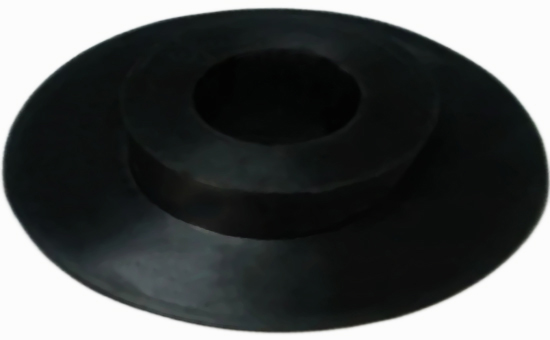
Butyl reclaimed rubber has excellent air tightness, water tightness, good heat resistance, ozone resistance, shock absorption, etc. It can be used alone or in combination with butyl raw rubber, EPDM rubber, and EPDM reclaimed rubber to produce rubber products , reduce costs on the premise of ensuring product quality. When using butyl reclaimed rubber to produce rubber products, the design of the vulcanization system in the rubber formula directly affects the performance and performance of the finished product. The editor will share with you the key points of the basic vulcanization formula of butyl reclaimed rubber today.
When using butyl reclaimed rubber to produce rubber products, sulfur vulcanization, phenolic resin vulcanization and quinone oxime system vulcanization can be used. When sulfur is used as vulcanizing agent, the processing performance of butyl reclaimed rubber and the comprehensive performance of vulcanized rubber are better; the butyl reclaimed rubber after resin vulcanization has good high temperature resistance, and is generally used in the production of water tires, diaphragms, vulcanized bladders and other products. At times, butyl reclaimed rubber is often used in combination with butyl rubber; butyl reclaimed rubber vulcanized with a quinone oxime vulcanization system has a faster vulcanization speed, and the vulcanized rubber is more compact, heat-resistant and ozone-resistant.
1. Key points of butyl reclaimed rubber sulfur vulcanization system coordination
(1) Key points of vulcanizing agent in sulfur vulcanization system of butyl reclaimed rubber
When butyl reclaimed rubber/butyl reclaimed rubber is used for sulfur vulcanization, the amount of sulfur is generally controlled at about 1.5 parts, and it is easy to bloom if the amount is too much; when the amount of butyl reclaimed rubber is large, the amount of sulfur can be appropriately increased. Using sulfur vulcanized butyl reclaimed rubber 2ELYY69, butyl rubber/reclaimed rubber combined rubber can form polysulfide bond, disulfide bond crosslinking structure or monosulfide bond crosslinking structure.
In actual production, butyl reclaimed rubber that forms a polysulfide bond or disulfide bond cross-linked structure is vulcanized with a large amount of sulfur, which is a common vulcanization system; the reclaimed rubber vulcanizate has high mechanical strength. The amount of sulfur in the basic vulcanization formula of butyl reclaimed rubber is less than 1 part or the use of sulfur donor vulcanization will form a monosulfide bond cross-linking structure, which is an effective vulcanization system. At this time, it is necessary to appropriately increase the amount of accelerator; Butyl reclaimed rubber vulcanizate has better heat resistance, ozone resistance and compression resistance.
(2) Key points of coordination of activator for butyl reclaimed rubber sulfur vulcanization system
Sulfur-vulcanized butyl rubber, butyl reclaimed rubber, and butyl/butyl reclaimed rubber will generate hydrogen sulfide during vulcanization, a compound that destroys disulfide bonds in the compound and initiates a redox reaction. In the sulfur vulcanization system of the butyl rubber compound, an appropriate amount of zinc oxide is added. Zinc oxide can react with hydrogen sulfide to produce zinc sulfide, preventing redox, and the vulcanization process of butyl rubber/butyl reclaimed rubber will no longer be disturbed.
In actual production, the amount of zinc oxide in the sulfur vulcanization system of butyl reclaimed rubber and butyl rubber/butyl reclaimed rubber is generally controlled at about 5 parts; at the same time, it is necessary to use an appropriate amount of stearic acid, and the amount of stearic acid is not recommended to exceed 3 parts , too much dosage will affect the tensile stress of butyl reclaimed rubber vulcanizate.
(3) The key points of the butyl reclaimed rubber sulfur vulcanization system accelerator coordination
Butyl reclaimed rubber vulcanized with sulfur generally uses thiuram accelerators or carbamate accelerators, and the vulcanization speed is fast; it is recommended to use one or more main accelerators and an auxiliary accelerator together for better coordination Relationship among cure rate, crosslink density, scorch safety, and butyl reclaimed vulcanizate properties.
When butyl reclaimed rubber is vulcanized with sulfur, thiuram accelerators are mostly used as main accelerators. Accelerator TMTD (generally no more than 1.5 parts) is the most commonly used, which can be used in combination with accelerator M/DM, or with dithioamino Formate combined. When the accelerator M and the accelerator DM in the thiazole accelerators are used as auxiliary accelerators, they can not only promote vulcanization, but also prevent scorch during processing. Dithiocarbamate accelerators are similar in structure to thiuram, but more active. When thiuram accelerators and zinc dithiophosphate are used together, the butyl reclaimed rubber vulcanizate has low heat generation, high tensile stress and small compression deformation.
The basic vulcanization formula of butyl reclaimed rubber can also use resin vulcanization system and quinone oxime vulcanization system. The editor will continue to discuss related issues with you in the next issue.
Exclusive original article [commercial authorization] reprint, excerpt and excerpt in any form are prohibited without written authorization. Focus on Hongyun rubber: learn the process formula and raw material technology of producing rubber products from recycled rubber to help you reduce costs and increase profits